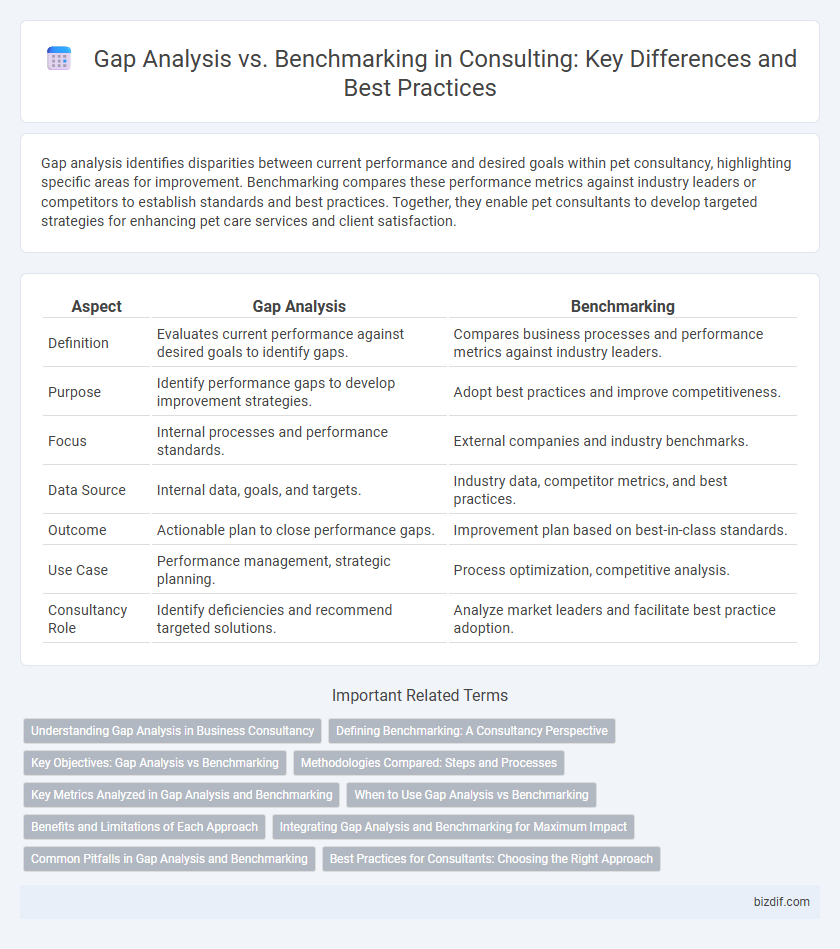Gap analysis identifies disparities between current performance and desired goals within pet consultancy, highlighting specific areas for improvement. Benchmarking compares these performance metrics against industry leaders or competitors to establish standards and best practices. Together, they enable pet consultants to develop targeted strategies for enhancing pet care services and client satisfaction.
Table of Comparison
| Aspect | Gap Analysis | Benchmarking |
|---|---|---|
| Definition | Evaluates current performance against desired goals to identify gaps. | Compares business processes and performance metrics against industry leaders. |
| Purpose | Identify performance gaps to develop improvement strategies. | Adopt best practices and improve competitiveness. |
| Focus | Internal processes and performance standards. | External companies and industry benchmarks. |
| Data Source | Internal data, goals, and targets. | Industry data, competitor metrics, and best practices. |
| Outcome | Actionable plan to close performance gaps. | Improvement plan based on best-in-class standards. |
| Use Case | Performance management, strategic planning. | Process optimization, competitive analysis. |
| Consultancy Role | Identify deficiencies and recommend targeted solutions. | Analyze market leaders and facilitate best practice adoption. |
Understanding Gap Analysis in Business Consultancy
Gap Analysis in business consultancy identifies the difference between a company's current performance and its desired goals, providing a clear framework for improvement. It focuses on pinpointing specific areas where processes, skills, or resources are lacking, enabling consultants to develop targeted strategies for growth and efficiency. This method delivers actionable insights by highlighting performance gaps and driving focused interventions to achieve competitive advantage.
Defining Benchmarking: A Consultancy Perspective
Benchmarking in consultancy involves systematically comparing an organization's processes, performance metrics, and practices against industry leaders or best-in-class companies to identify gaps and areas for improvement. This process provides actionable insights that help organizations develop effective strategies and enhance operational efficiency by learning from the successes of others. By leveraging quantitative and qualitative data, consultancy firms enable targeted improvement plans that align with client objectives and competitive standards.
Key Objectives: Gap Analysis vs Benchmarking
Gap analysis focuses on identifying discrepancies between current performance and desired goals, enabling organizations to develop targeted improvement strategies. Benchmarking emphasizes comparing processes and performance metrics against industry leaders or competitors to uncover best practices and set realistic standards. Both approaches aim to enhance operational efficiency but serve complementary roles in strategic decision-making.
Methodologies Compared: Steps and Processes
Gap analysis methodology involves identifying current performance metrics, defining desired performance standards, and analyzing discrepancies to formulate improvement strategies. Benchmarking consists of selecting industry leaders, systematically comparing key performance indicators, and integrating best practices to achieve competitive advantage. Both methodologies emphasize data collection and performance evaluation but differ in focus: internal improvement for gap analysis versus external performance comparison in benchmarking.
Key Metrics Analyzed in Gap Analysis and Benchmarking
Gap analysis focuses on internal key metrics such as performance efficiency, process effectiveness, and resource utilization to identify discrepancies between current and desired states. Benchmarking evaluates external metrics including industry standards, competitor performance, and best practices to establish performance baselines. Both methods emphasize quantitative data like productivity ratios, customer satisfaction scores, and financial indicators to drive strategic improvements.
When to Use Gap Analysis vs Benchmarking
Gap analysis is ideal when identifying specific performance deficiencies and defining actionable steps to bridge those gaps within internal processes or capabilities. Benchmarking is more effective for comparing an organization's practices, performance metrics, and strategies against industry leaders or competitors to adopt best practices and improve standards. Use gap analysis for internal improvements and benchmarking for external performance comparisons and strategic alignment with market leaders.
Benefits and Limitations of Each Approach
Gap analysis identifies discrepancies between current performance and desired goals, enabling targeted improvement strategies but may overlook industry standards. Benchmarking compares organizational processes and performance metrics against top competitors, providing external insights yet risks promoting imitation over innovation. Both approaches complement each other by balancing internal focus with external best practices, optimizing strategic decision-making in consultancy.
Integrating Gap Analysis and Benchmarking for Maximum Impact
Integrating gap analysis and benchmarking enhances consultancy outcomes by identifying performance shortfalls compared to industry leaders and setting actionable improvement targets. Gap analysis reveals internal weaknesses in processes, skills, or resources, while benchmarking provides external reference points and best practices from top competitors. Combining both approaches enables consultants to develop strategic roadmaps that prioritize closing critical gaps through proven methods, driving sustainable growth and competitive advantage.
Common Pitfalls in Gap Analysis and Benchmarking
Common pitfalls in gap analysis include setting unrealistic benchmarks, overlooking internal capabilities, and failing to align gaps with strategic objectives. In benchmarking, organizations often struggle with selecting irrelevant comparators, relying on outdated data, and misinterpreting performance metrics. Both methods require careful contextualization to provide actionable insights that drive performance improvements.
Best Practices for Consultants: Choosing the Right Approach
Gap analysis identifies performance deficiencies by comparing current processes against desired standards, enabling consultants to target specific improvement areas. Benchmarking evaluates an organization's practices against industry leaders to uncover best practices and set competitive performance goals. Selecting the right approach depends on whether the priority is internal performance enhancement through gap closure or external performance elevation via adoption of proven best practices.
Gap Analysis vs Benchmarking Infographic

 bizdif.com
bizdif.com